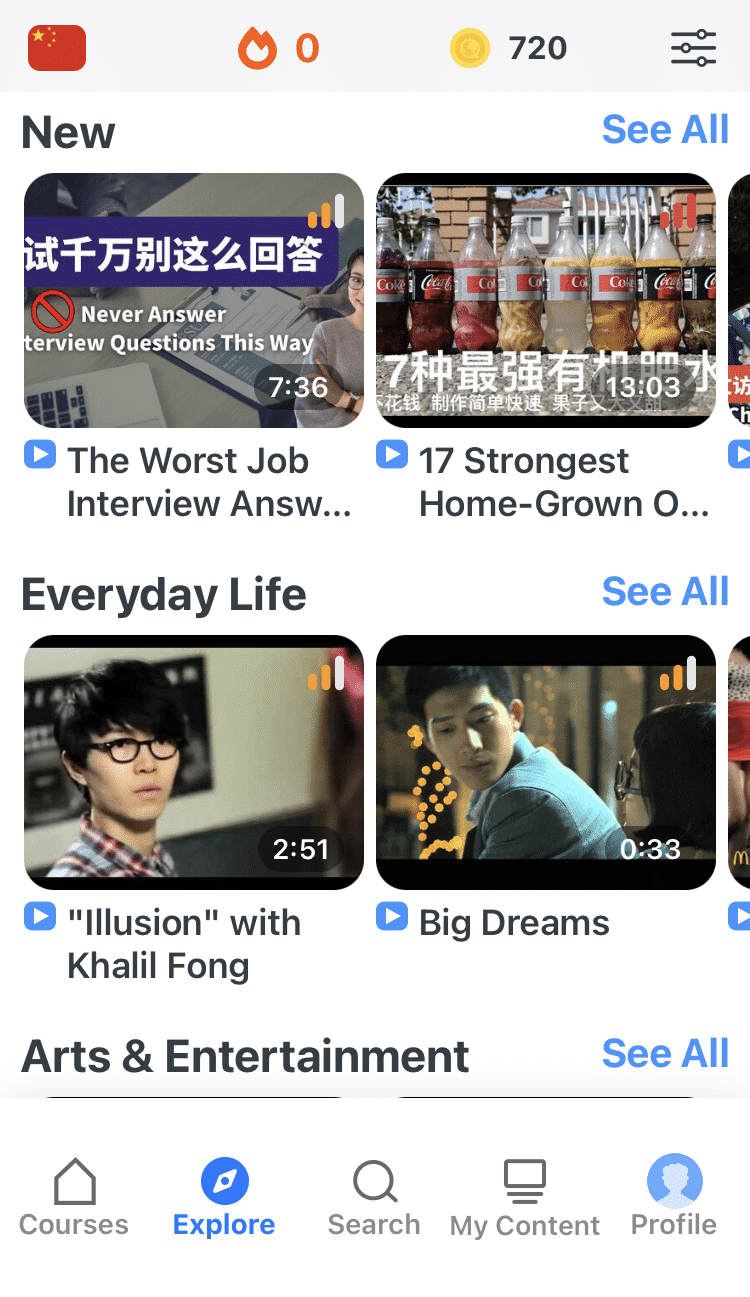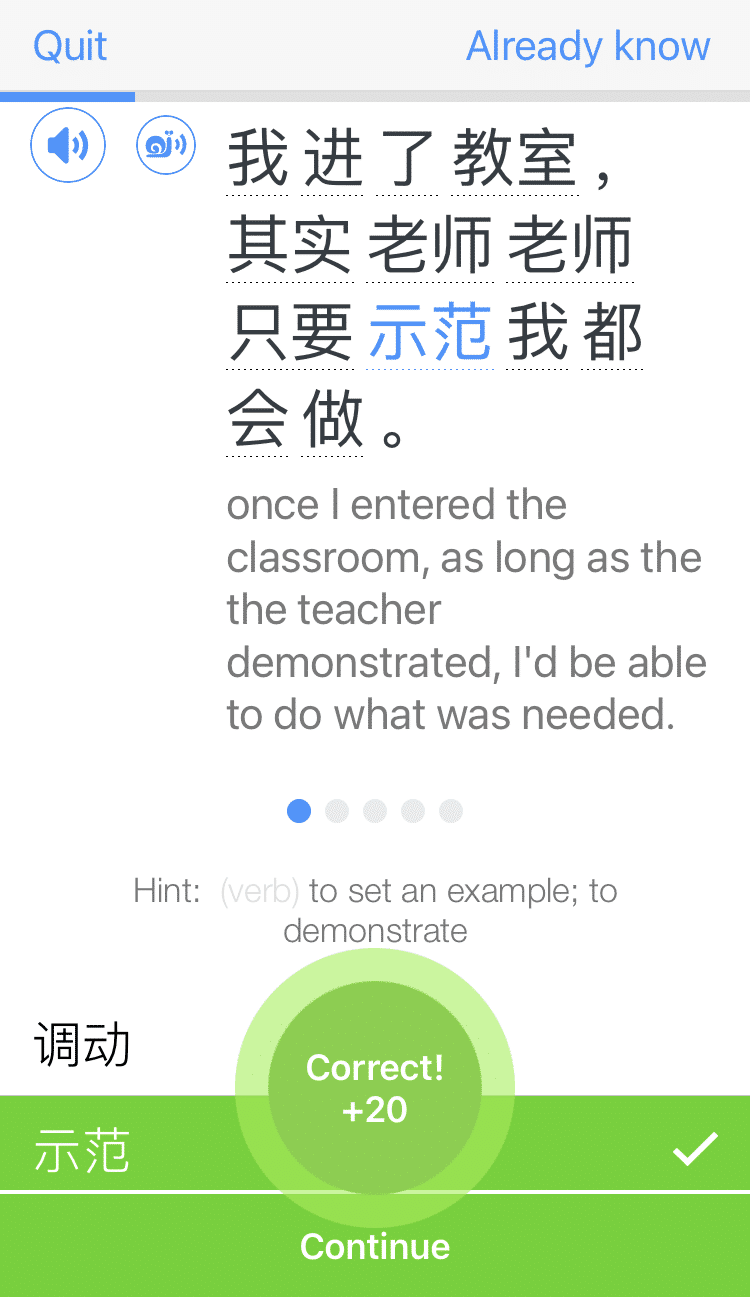How to Improve Chinese Listening Skills Actively and Passively

Using Chinese for the first time with a native can be a wake-up call for some learners. For example, maybe you feel like you’ve mastered how to ask for directions.
You ask a passerby for directions, and they reply—but you couldn’t fully understand what they said.
Speaking is one half of having a conversation; if you want to truly master Chinese (or any language really), you have to understand what’s being said to you.
Download: This blog post is available as a convenient and portable PDF that you can take anywhere. Click here to get a copy. (Download)
How to Practice Active Listening in Chinese
Active listening involves listening to a recording repeatedly so that you understand everything—or almost everything.
For active listening, I recommend the following:
1. Listen to the entire recording
You want to listen to the whole recording at least once before you look at the text, so you can evaluate how much you were able to understand. On the first listen, don’t worry too much about taking notes, just focus on understanding as much as possible.
2. Play the recording a second time
This time, try to jot down any words you don’t recognize or parts that confuse you. You should understand more than the first time, including recognizing vocabulary and grammar that you know but didn’t understand the first time.
3. Read a transcript of the audio
As you read the transcript, you should be able to evaluate how accurately you were able to understand the audio. When you read the transcript, look up any words you don’t know and if you find any grammar constructions you don’t understand, do the same.
The goal after reading the transcript is to understand completely what was said in the recording. It’s common for language learners to think they understood something, only to go through the transcript and realize they misunderstood. Don’t be discouraged if that happens to you. You should actually expect it.
4. Listen again while reading along with the transcript
In this last step, you are putting it all together. By reading along, you are reinforcing in your head how the words should sound. It can be useful to do this more than one time, but the important thing is to read along while listening at least once.
Bonus step: Read out loud, mimicking the recording, as you listen one last time. This really helps solidify the way each word should sound.
Active Listening Resources
Finding resources for active listening is more difficult because you need audio that comes with a transcript. For active listening, materials specifically aimed at language learners can be incredibly useful, because they often have transcripts. Here are some choice resources.
- Audiobooks — Audiobooks are great for advanced learners, although even advanced learners shouldn’t focus intensely on more than 5 minutes of recorded audio at a time. It’s impossible to intensively study an audiobook, making sure you understand every word with a recording that lasts for hours. You can use snippets of the audio for active listening, and use the rest for passive listening practice.
- FluentU — FluentU is especially useful for listening practice because it focuses on learning with video content that was created by native speakers.
FluentU takes authentic videos—like music videos, movie trailers, news and inspiring talks—and turns them into personalized language learning lessons.
You can try FluentU for free for 2 weeks. Check out the website or download the iOS app or Android app.
P.S. Click here to take advantage of our current sale! (Expires at the end of this month.)
- Resources combining text and audio for Chinese learners — Tools like iMandarinPod and apps like Chinese Stories – Elementary include recordings with transcriptions of news items, stories about 成语 (chéng yǔ) or idioms and other short, culturally relevant texts.
How to Practice Passive Listening in Chinese
Passive listening is another technique for improving your listening comprehension in Chinese.
With passive listening, your goal is to listen to as much Chinese audio as possible. The idea is to get as much input as you can and to increase your exposure to Chinese.
You don’t need to understand every word of every sentence. Passive listening isn’t about learning new vocabulary or grammar structures. The goal is to solidify things you have already learned, as well as to practice recognizing language in context when used by different speakers.
Passive listening helps you get a “feel” for the language. That’s a touchy-feely way of saying that you become more comfortable with the intonation pattern of the sentences, when speakers tend to pause, how long sentences should be, etc.
This is the best time to acquaint yourself with non-standard accents, as well as to get used to listening and understanding Chinese with noise in the background. That’s partially because you’ll likely be doing other things while working on your passive listening.
It’s an ideal language learning activity to do while you do something else, like clean your house or drive somewhere. Passive listening is a way to stack learning Chinese with other activities in your life. With this strategy, you can get more exposure to Chinese without giving up any of the other important things you do.
For passive listening, I recommend the following steps:
1. Choose a type of audio
You should be able to listen to the audio for a while without changing it. This could be a song that you’ll listen to on repeat for an hour, your ultimate Chinese playlist or an hour-long podcast. You can also use audio you have already studied, such as textbook audio or familiar podcasts. Music also works and is much easier to combine with other tasks. The goal is that you don’t want to fuss with your audio every five minutes.
2. Listen in a relaxed way
Pay attention, but don’t worry about understanding everything. Instead, notice the cadence and try to understand the general topic. Apart from hearing the intonation and rhythm of the language all the time, you will also hear a few expressions here and there.
3. Repeat, with the option to multitask
Like with active listening, you’ll always understand more the second time you listen to something, especially if you are listening while doing something else. This makes a song playing on repeat for an hour an ideal passive listening exercise!
Passive Listening Resources
Some great resources for passive listening audio practice are:
- Chinese music — It’s perfect to just put some music on while you’re cleaning or showering. Spotify is a good place to find Chinese music, just type in “Chinese playlist” or “Chinese music” to see what they have.
Music is great for beginners because you can use one individual song for active listening if you want to understand everything, and you can then listen to that song on repeat for passive practice. You don’t have to understand all the words to enjoy the music, either!
- Chinese podcasts — This is better for intermediate and advanced learners who should be able to understand at least some of the podcasts without having to put in much effort. Apple Podcasts, Google Podcasts and Spotify have a ton of options for various levels of learners.
- Chinese TV — Also a good option for intermediate and advanced learners, Chinese TV is a bit easier than a podcast because you can get visual cues about what is going on, so you can often follow the action even if you don’t understand all of the language happening. The best resource for Chinese TV is CCTV. There are also whole programs and movies on Youku and YouTube.
- Chinese radio stations – Compared to podcasts, Chinese radio stations give you a more spontaneous element because you can simply tune in and listen to a variety of programs that are already on air. It’s also ideal for passive listening because it’s hands-off—there’s already a continuous stream of audio! Online Radio Box has a wide selection of Chinese stations, from pop music to news reports.
Why is Chinese Listening so Hard (but so Important)?
First-time language learners are often surprised by how difficult listening to Chinese is. Even seasoned polyglots have been known to stumble with Chinese listening.
Here are a few reasons why it’s hard, which are coincidentally also reasons why you should focus on improving your listening skills.
Chinese speakers have a variety of non-standard accents
Many—you might even say all—native Chinese speakers have a non-standard accent. Nobody really speaks 普通话 (pǔ tōng huà) or Standard Mandarin natively. It’s something most Chinese speakers learn to do in school.
Chinese speakers who don’t regularly interact with foreigners will likely speak with you in the same way they would speak with another Chinese speaker, in their local, familiar accent. If you have never been exposed to these variations and/or already lack listening practice, a slightly non-standard pronunciation can throw you off.
The world is full of background noise and distractions
In the real world, we don’t often converse in a silent room. The hypothetical conversation above of a learner asking for directions would probably happen on the street. A bus might be slamming on its brakes while schoolchildren giggle behind you. All these distractions make it even harder to understand.
Word choice can throw curve balls
Native speakers generally understand the simple words that language learners use. However, native speakers will not necessarily use those same words in their responses. They might use a slang term, or simply a word that you haven’t learned yet.
If you’re unfamiliar with the location and its place names, you might have trouble differentiating between proper nouns and regular nouns. To give yourself the biggest advantage possible, you need to make sure you at least understand all of the words you already know how to say. From there, you can work on piecing together the ones that you don’t.
Both active and passive listening are crucial for advancing your Chinese listening skills.
The good news is that they’re both great ways to interact with the Chinese language and culture.
So, make time to integrate both types of listening practice into your study routine!
Download: This blog post is available as a convenient and portable PDF that you can take anywhere. Click here to get a copy. (Download)
And One More Thing...
If you want to continue learning Chinese with interactive and authentic Chinese content, then you'll love FluentU.
FluentU naturally eases you into learning Chinese language. Native Chinese content comes within reach, and you'll learn Chinese as it's spoken in real life.
FluentU has a wide range of contemporary videos—like dramas, TV shows, commercials and music videos.
FluentU brings these native Chinese videos within reach via interactive captions. You can tap on any word to instantly look it up. All words have carefully written definitions and examples that will help you understand how a word is used. Tap to add words you'd like to review to a vocab list.
FluentU's Learn Mode turns every video into a language learning lesson. You can always swipe left or right to see more examples for the word you're learning.
The best part is that FluentU always keeps track of your vocabulary. It customizes quizzes to focus on areas that need attention and reminds you when it’s time to review what you’ve learned. You have a 100% personalized experience.
Start using the FluentU website on your computer or tablet or, better yet, download the FluentU app from the iTunes or Google Play store. Click here to take advantage of our current sale! (Expires at the end of this month.)











